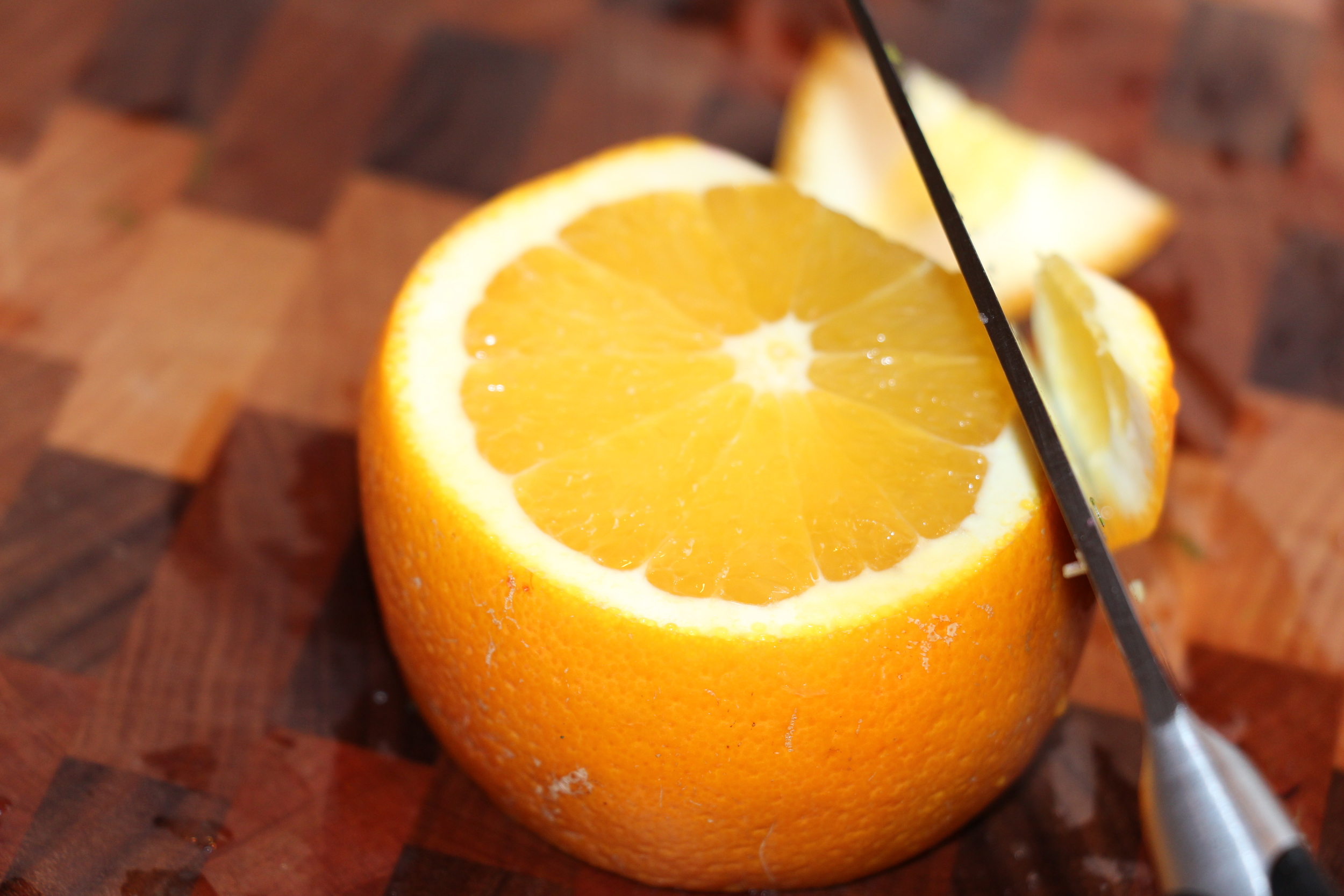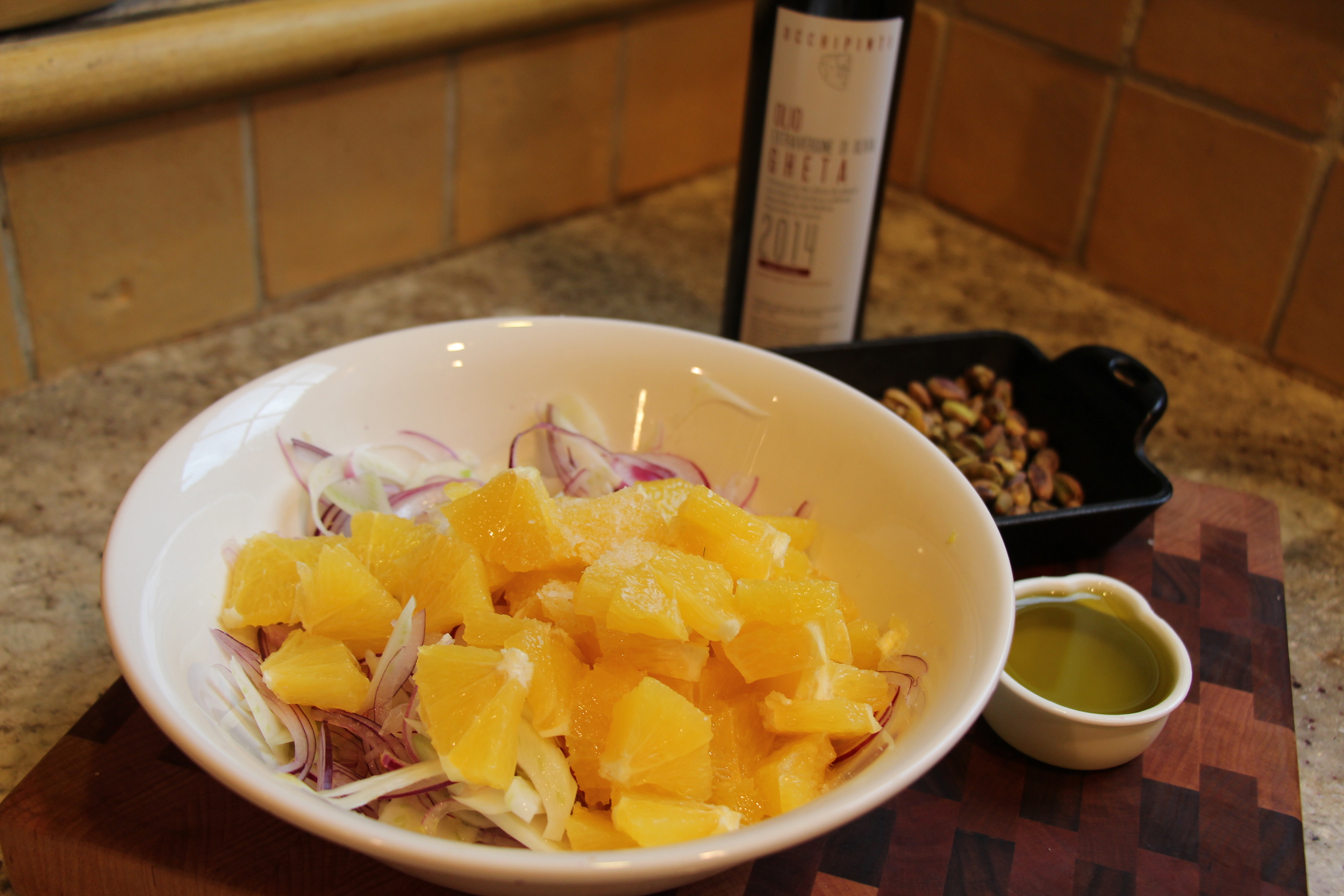And now for the important stuff…the food. (And because I am me, the wines that go with it).
Snails at the Piscaria Mercato, Catania
The quality of the seafood in Sicily was really impressive. Everything was fresh and for the most part prepared simply with a minimum of fuss. While there are quite a few Michelin-starred restaurants on the island, my husband Jeff and I did not seek them out, as usual preferring to eat traditional fare. The one restaurant that we did eat at which employed more sophisticated techniques only confirmed my prejudice. Although perfectly prepared and using very fresh local ingredients, the food did not really speak to me. In fact, it left me cold.
Spaghetti Alio, Olio e Pepperoncino, Lido Tropicana, Taormina Mare
We had some very good meals in Taormina which was a harder task because the town is the number one tourist destination in Sicily. Ristorante Nettuno, Da Nino, Tira Misu, Paladino were all good, offering versions of local fresh fish, seafood or pastas with bottarga and sea urchin. Surprisingly enough, the restaurants at the beach concessions were quite good, though we did stick to some pretty safe choices like grilled squid or pasta with garlic, olive oil and red pepper—one of my favorites!
Another surprise? Dessert! As I have stated before, I am not a dessert eater. I am a cheese eater. However, in Sicily? Pistachio heaven? Source of the much sought after Pistachio di Bronte (grown on the slopes of Mt. Etna)? I had to try Pistachio Gelato. I had a scoop of it while lazing under an umbrella on the beach at Isola Bella and while it might be true that the scenery enhanced my enjoyment, I cannot deny that that was pretty darn good gelato--nutty, slightly salty and not overly sweet.
The other dessert that I had to try? Cannoli. I have always known that Cannoli are from Sicily, but I’ve never really been impressed with them. Oh my goodness, have I been wrong. The crisp hollow shells break when you bite into them, causing the lightly sweet chocolate chip studded ricotta cheese filling to gush out--so delicious. It’s dessert, but it’s cheese too. What more could a cheese-loving woman like me want? (I could want them to be as good in Washington DC as they are in Sicily, that’s what). One of the secrets is piping the filling into the crunchy barely sweet shells at the last possible moment before serving them. This seems like a viable new hobby, finding perfect cannoli in Washington DC that I don’t have to make myself.
The wines, like the food, were pleasing and affordable--white wines from Etna like the Sabbie dell’Etna from Firriato made from Carricante and Cattaratto. I was particularly taken by the Etna rosés made from the local Nerello Mascalese grape. Highly regarded in wine circles, Nerello Mascalese is thought to be a cross of Sangiovese with another grape (which one is still up for debate). It ripens late and produces red-fruited wines with good acidity and light tannins. In its rosé form, I found the cherry fruit and salty minerality to be a perfect pairing for seafood. It becomes a more serious grape when made into red wine. Of particular distinction was the 2013 Tenuta delle Terre Nere Etna Rosso “Santo Spirito” which maintained the cherry notes found in the rosés but emphasized minerality and smoky soft herbs while exhibiting silky tannins and impressive length. It was recommended at Da Nino, a traditional Sicilian restaurant with an impressive wine list and a talented sommelier to guide you through it.
Away from Taormina with its throngs of tourists, Antica Marina served up my favorite restaurant meal in Sicily. Located in the bustling fish market that is Catania’s Piscaria, the seafood and fish available to this small, established restaurant provide a bounty of ingredients to make the chef in me sigh.
Frittura di Paranza, Antica Marina, Catania
Here, once again, we stuck to very basic dishes, meltingly tender octopus salad, sautéed baby clams, their olive oil, lemon and red pepper spiked broth almost as delicious as the succulent bivalves themselves and a new take for me on a classic seaside staple, fried fish or in this case—Frittura di Paranza. I don’t mean to imply that they did anything revolutionary with this dish of fried fish and calamari; it was the fish itself that made the difference. First, they were very small—the longest fish was about two and half inches in length and served headless but otherwise whole, bones and all. The calamari tentacles served with it were tiny—some of the smallest I’ve seen. Second, they could not have been any fresher. (Paranza means fish net or trawler in Italian, but in this case, it means small freshly caught fish—likely right out of the fish net.) Wow, just wow. The crunch of the breadcrumb coating and the crispy yet completely edible bones made for such an amazing contrast with the flaky flesh—so delectable. Served with a perfectly chilled glass of Grillo, an aromatic, full-bodied Sicilian white wine, this dish hit it out of the park.
Also excellent were the Ravioli Maniace (housemade ravioli stuffed with shrimp and orange zest and coated with a creamy orange, pistachio, tomato basil sauce) and Fish Soup for two at Osteria Seby in Ortigia. Because we had been eating out every meal and that is a lot rich of food, I ordered a fennel and orange salad preferring something light for my first course. As I watched my husband Jeff happily consume his ravioli, I asked myself why I wasn’t enjoying my salad to the same extent. It occurred to me that my salad was a perfect example of what not to do in Wine Table cooking.
One of the key rules I live by is that if you use very few ingredients, they have to be perfect—which they should have been. In this case my complaint wasn’t with the sourcing of the ingredients. You can’t get much better than buying Sicilian oranges in Sicily. The problem was the way the ingredients were cut. The fennel and onions for the salad were quite thick—so that rather than get a mouthful of the three ingredients melding together, you got chunks of onion or fennel with the flavor of the oranges relegated to a distant third place. Simple techniques are not the same as careless ones, rather the opposite. If you only have a few ingredients, the texture of those ingredients is key and careful knife techniques are important.
As I watched Jeff finish eating his ravioli with what I can only term as indelicate haste, my mind wandered to ways of making my salad better—plotting to improve the dish upon my return home. Would grilling the ingredients blend the flavors together? In the end, rather than putting an extreme twist on the salad like grilling it, I tweaked it slightly, finely shaving the fennel and onions, substituting red onions for white ones, using a high-quality olive oil (in this case the Occhipinti Gheta 2014) and garnishing it at the last minute with chopped toasted pistachios—an homage to the flavors of Sicily.
Orange, Fennel and Red Onion Salad with Pistachios
En route to visit winemaker Arianna Occhipinti, we saw orange groves with trees laden with ripe fruit, the ground surrounding the trees dotted with fallen oranges. In fact, one such grove abutted the highway and the gutters along the road were filled with oranges. Arianna quoted an old Sicilian saying “Those who own oranges will cry,” because growing oranges takes so much work and yet their sales price is so low that there is little profit from the endeavor, which is to say, it is a hard way to earn a living. It’s really a shame. The oranges are juicy, sweet and delicious. It’s no wonder we saw this salad on the menu at numerous Sicilian restaurants. When life gives you oranges….
Yield: 4 servings as a side dish
Wine Pairing: Sicilian Grillo or Insolia
Ingredients:
3 large ripe oranges
1 medium fennel bulb
½ small red onion
1/8 cup extremely good quality olive oil
kosher salt
Dash of crushed red pepper flakes
1/4 cup finely chopped pistachios, toasted very lightly (Sicilian if you’ve got ‘em!)
Timing:
Prep Time: 15 minutes
Chilling Time (the salad’s, not yours): 30 minutes
What you’ll need:
A very sharp knife
Cutting Board
Salad Bowl
A Mandoline (optional)
Shave the fennel and red onions on the mandolin or slice it as thinly as possible with your knife. Place them in the salad bowl.
Cut ¾ inch slices off the ends of the oranges. Squeeze the juice from these six end pieces of oranges, reserving the juice to dress the salad. You should have approximately 1/3 of a cup of juice.
Using a semi-circular motion of your knife, remove the rinds and the white part of the orange. Slice the orange in 1/3 inch slices. Cut these orange slices in quarters. Add the quartered pieces of oranges to the shaved fennel and red onions in the salad bowl.
Pour the orange juice and the olive oil into the bowl. Add a couple of pinches of salt and a dash of red pepper flakes. Stir the salad ingredients together and chill in the refrigerator for at least 30 minutes.
When ready to serve, taste the salad to see if you are happy with the salt content. Adjust for seasoning and at the last minute before serving stir in the lightly toasted pistachios.
Difficulty: Moderate
Sourcing: Easy
Notes:
#1: It would be great if we all had access to Sicilian oranges, Pistachios from Bronte and Arianna Occhipinti’s amazing oil. However, we do have excellent substitutes for these products in the United States. Use the best quality you can find and enjoy.
#2: Mandolines are extremely useful tools. Prices range from very expensive French versions to cheaper Benriner Asian models that work really well. I use a nifty little Oxo version because it fits easily in my utensil drawer and is dishwasher safe. A word of caution: Mandolines should be used with extreme care. Keep your fingers away from the blade. They can and will take the tip off an unsuspecting finger in the blink of an eye.







